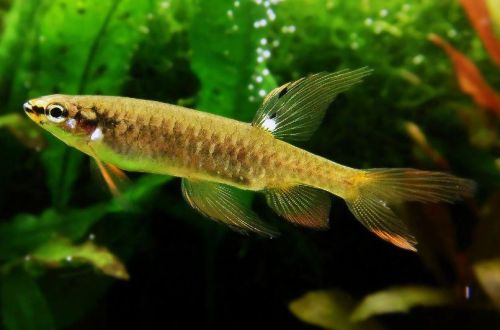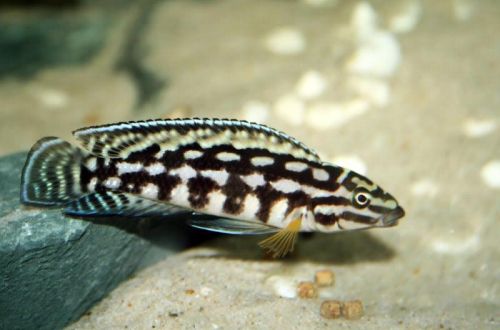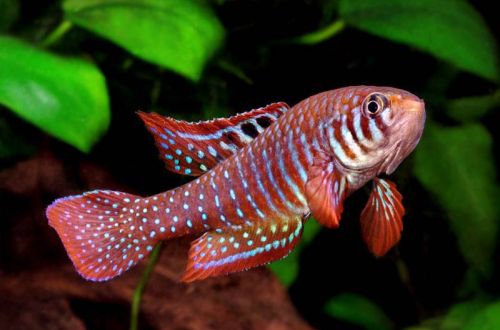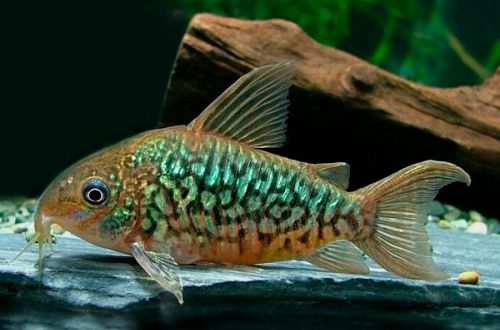
Kopein Arnold
Pyrrulina or Copein Arnold, scientific name Copella arnoldi, belongs to the Lebiasinidae family. The beautiful, slender fish features an amazing way of hatching eggs, captured in several non-fiction BBC and National Geographic wildlife films. The name is given in honor of two researchers – naturalist Edward Drinker Cope, who first scientifically described this species, and J. Paul Arnold, who collected wild specimens for the British Museum.

Habitat
Widely distributed in the lower part of the Amazon basin (South America) in Brazil, Suriname, Guiana. Inhabits small streams and tributaries of rivers, as well as flooded rainforest substrate during high tide. Prefers areas with low overhanging coastal vegetation.
Description
Low elongated body with large scales. Males are slimmer and longer than females and have larger fins. Coloration brownish-gold. Males are more brightly colored. Depending on the region of origin, the pattern and coloring may vary slightly.
Food
In nature, they feed on small invertebrates and other zooplankton near the surface of the water. At home, they will accept any dry floating food, provided that it contains protein supplements, otherwise meat food is required. Live food can be: grindal worm, brine shrimp, nauplii, Drosophila flies.
Maintenance and care
Spacious aquarium from 120 liters with rich vegetation arranged in groups and shelters in the form of tree roots and branches. Floating plants are welcome, but do not let the surface become overgrown. Any dark soil with a certain amount of tree leaves at the bottom, previously dried. They color the water in a light brown hue, characteristic of their natural habitat. If breeding is planned, then a closed paludarium will be required, filled to ¾ of the volume with plants hanging close above the surface (see below for why this is needed).
Copeine Arnold is sensitive to the hydrochemical composition of water and does not tolerate fluctuations in pH and dH. Optimal conditions are soft acidic or slightly acidic water. Refresh once a week by 15–20% while cleaning the soil with a siphon. It is more expedient to carry out water treatment with the help of special reagents that change the composition of water. Sold in pet stores or over the Internet in places with test kits (usually in the form of litmus papers).
The minimum set of equipment consists of a filtration system, heater, lighting and aeration system.
Behavior
Schooling rather peaceful schooling fish. Males often engage in fights without causing much harm to each other. Such competition is due to the struggle for the attention of females, while males show the brightest colors. In the case of a harem content – 1 male and several females, it becomes faded, inconspicuous. Compatible with most peaceful species. It is not permissible to keep with large and aggressive species.
Breeding / breeding
The fish is distinguished by an extremely interesting way of protecting caviar. It is deposited on the leaves of plants hanging over the water. During the courtship period, the male selects the desired leaf by repeatedly jumping out of the water. Then he invites the female and make a pair jump. With the help of the pelvic fins, they cling to the surface of the sheet, in this position they can hold out for up to 10 seconds. At this time, the female attaches the eggs, and the male fertilizes them.
About 10–12 eggs are attached in one pair jump, then the procedure is repeated until the female lays about 100–200 eggs. In the future, the female no longer takes any part in caring for offspring and swims away. The male, on the contrary, remains in close proximity and periodically splashes water with the help of fins and tail, moistening the eggs. He does this from 36 to 72 hours, until the appearance of fry, which, together with splashes, fall into the water.
In some cases, the male courts several females and is forced to maintain several batches of eggs on different leaves, constantly swimming from one to another. After the appearance of offspring, the parental instinct dries up. Juveniles should be caught and placed in a separate tank with identical water conditions.
Due to the peculiarities of breeding, the presence of emersed plants is mandatory, the leaves should hang over the water no further than 10 cm, while it is not necessary that they be living plants, it is allowed to use artificial ones.
Fish diseases
The main cause of Pyrrulina’s health problems are inappropriate conditions of detention, causing a weakening of the immune system and thereby increasing susceptibility to diseases. Read more about symptoms and treatments in the Aquarium Fish Diseases section.





